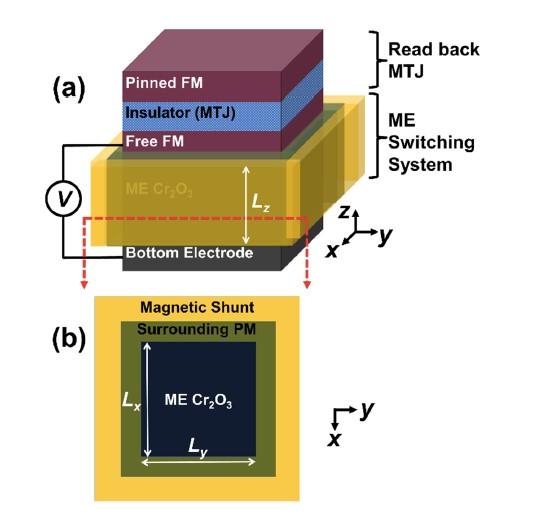Design for magnetoelectric device may improve your memory

This image shows the (a) side and (b) overhead views of the proposed switching element show the chromia at the center, surrounded by a magnetic shunt to block magnetic fields, and the read head on top. Credit: Ahmed and Victora
For years, manufacturers have offered computers with increasing amounts of memory packed into smaller devices. But semiconductor companies can't reduce the size of memory components as quickly as they used to, and current designs are not energy-efficient. Conventional memory devices use transistors and rely on electric fields to store and read out information.
An alternative approach being heavily investigated uses magnetic fields to store information. One promising version of magnetic device relies on the magnetoelectric effect which allows an electric field to switch the magnetic properties of the devices. Existing devices, however, tend to require large magnetic and electric fields that are difficult to produce and contain.
One potential solution for this problem is a new switching element made from chromia (Cr2O3), which, one day, may be used in computer memory and flash drives. “The device has better potential for scaling, so it could be made smaller, and would use less energy once it's suitably refined,” said Randall Victora, a researcher at the University of Minnesota and an author on the paper. The researchers report their findings in Applied Physics Letters, from AIP Publishing.
Computer memory is composed of switching elements, tiny devices that can switch on and off to store bits of information as ones and zeros. Previous researchers discovered that chromia's magnetoelectric properties means it can be “switched” with only an electric field, but switching requires the presence of a static magnetic field. Building on these elements, Victora and Rizvi Ahmed have created a design for a memory device with a heart of chromia that does not require any externally applied magnetic field to operate.
Their design surrounds the chromia with magnetic material. This provides an effective magnetic field through quantum mechanical coupling to Cr magnetic moments, while allowing devices to be arranged in a way that blocks stray magnetic fields from affecting nearby devices. An element to read out the state of the device, to determine if it's in one or zero state, is placed on top of the device.
This could potentially pack more memory into a smaller space because the interface between the chromia and the magnet is the key to the coupling that makes the device function. As the device shrinks, the greater surface area of the interface relative to its volume improves the operation. This property is an advantage over conventional semiconductors, where increases in surface area as size shrinks lead to greater charge leakage and heat loss.
Next, Victora and Ahmed aim to collaborate with colleagues who work with chromia to build and test the device. If successfully fabricated, then the new device could potentially replace dynamic random access memory in computers.
“DRAM is a huge market. It provides the fast memory inside the computer, but the problem is that it leaks a lot of charge, which makes it very energy-inefficient,” Victora said. DRAM is also volatile, so information disappears once the power source is interrupted, like when a computer crash erases an unsaved document. This device, as described in the paper, would be nonvolatile.
However, such a memory device will likely take years to perfect. One significant barrier is the device's heat tolerance. Computers generate a lot of heat, and modeling predicts that the device would stop functioning around 30 degrees Celsius, the equivalent of a hot summer day. Optimizing the chromia, perhaps by doping it with other elements, may improve its functioning and make it more suitable to replace existing memory devices.
###
The article, “A fully electric field driven scalable magnetoelectric switching element,” is authored by Rizvi Ahmed and Randall H. Victora. The article appeared in Applied Physics Letters May 1, 2018, (DOI: 10.1063/1.5023003) and can be accessed at http://aip.
ABOUT THE JOURNAL
Applied Physics Letters features concise, rapid reports on significant new findings in applied physics. The journal covers new experimental and theoretical research on applications of physics phenomena related to all branches of science, engineering, and modern technology. See http://apl.
Media Contact
All latest news from the category: Physics and Astronomy
This area deals with the fundamental laws and building blocks of nature and how they interact, the properties and the behavior of matter, and research into space and time and their structures.
innovations-report provides in-depth reports and articles on subjects such as astrophysics, laser technologies, nuclear, quantum, particle and solid-state physics, nanotechnologies, planetary research and findings (Mars, Venus) and developments related to the Hubble Telescope.
Newest articles

NASA: Mystery of life’s handedness deepens
The mystery of why life uses molecules with specific orientations has deepened with a NASA-funded discovery that RNA — a key molecule thought to have potentially held the instructions for…

What are the effects of historic lithium mining on water quality?
Study reveals low levels of common contaminants but high levels of other elements in waters associated with an abandoned lithium mine. Lithium ore and mining waste from a historic lithium…

Quantum-inspired design boosts efficiency of heat-to-electricity conversion
Rice engineers take unconventional route to improving thermophotovoltaic systems. Researchers at Rice University have found a new way to improve a key element of thermophotovoltaic (TPV) systems, which convert heat…



